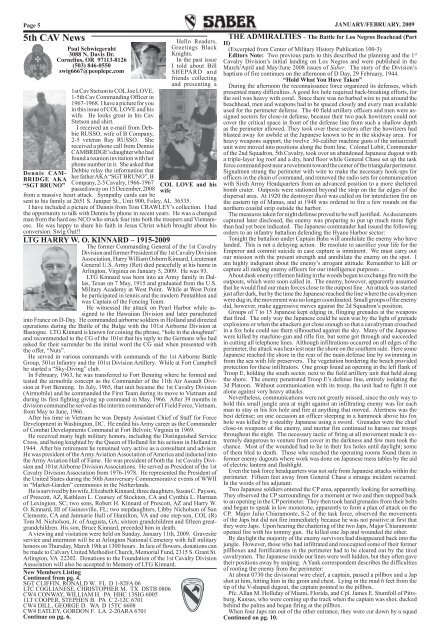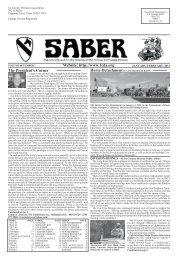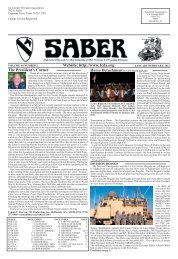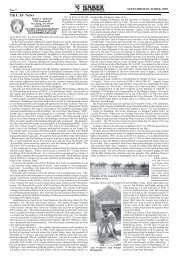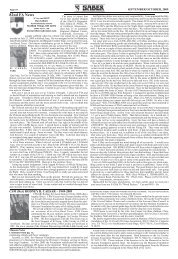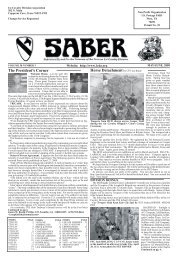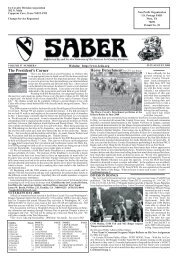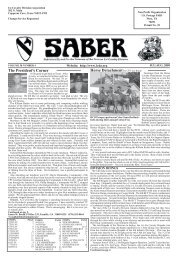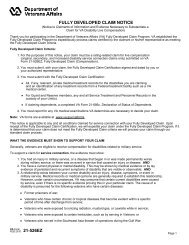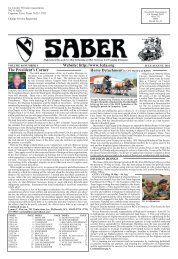Jan Feb '09 Saber.indd - First Cavalry Division Association
Jan Feb '09 Saber.indd - First Cavalry Division Association
Jan Feb '09 Saber.indd - First Cavalry Division Association
- No tags were found...
You also want an ePaper? Increase the reach of your titles
YUMPU automatically turns print PDFs into web optimized ePapers that Google loves.
Page 55th CAV NewsDennis CAM-BRIDGE AKA“SGT BRUNO”Paul Schwiegeraht3088 N. Davis Dr.Cornelius, OR 97113-8126(503) 846-0550swig6667@peoplepc.com1st Cav Stetson to COL Joe LOVE,1-5th Cav Commanding Officer in1967-1968. I have a picture for youin this issue of COL LOVE and hiswife. He looks great in his CavStetson and shirt.I received an e-mail from DebbieRUSSO, wife of B Company,2-5 veteran Ray RUSSO. Shereceived a phone call from DennisCAMBRIDGE’s daughter who hadfound a reunion invitation with herphone number in it. She asked thatDebbie relay the information thather father AKA “SGT BRUNO”, BCompany, 2-5 <strong>Cavalry</strong>, 1966-1967passed away on 15 December, 2008Hello Readers,Greetings BlackKnights.In the past issueI told about BillSHEPARD andfriends collectingand presenting aCOL LOVE and hiswifefrom a massive heart attack. Sympathy cards can besent to his family at 2651 S. Juniper St., Unit 900, Foley, AL 36535.I have included a picture of Dennis from Tom CRAWLEY’s collection. I hadthe opportunity to talk with Dennis by phone in recent years. He was a changedman from the hard ass NCO who struck fear into both the troopers and Vietnamese.He was happy to share his faith in Jesus Christ which brought about hisconversion. Swig Out!!LTG HARRY W. O. KINNARD – 1915-2009The former Commanding General of the 1st <strong>Cavalry</strong><strong>Division</strong> and former President of the 1st <strong>Cavalry</strong> <strong>Division</strong><strong>Association</strong>, Harry William Osborn Kinnard, LieutenantGeneral U.S. Army (Ret) died peacefully at his home inArlington, Virginia on <strong>Jan</strong>uary 5, 2009. He was 93.LTG Kinnard was born into an Army family in Dallas,Texas on 7 May, 1915 and graduated from the U.S.Military Academy at West Point. While at West Pointhe participated in tennis and the modern Pentathlon andwas Captain of the Fencing Team.He witnessed the attack on Pearl Harbor while assignedto the Hawaiian <strong>Division</strong> and later parachutedinto France on D-Day. He commanded airborne soldiers in Holland and directedoperations during the Battle of the Bulge with the 101st Airborne <strong>Division</strong> atBastogne. LTG Kinnard is known for coining the phrase, “hole in the doughnut”and recommended to the CG of the 101st that his reply to the Germans who hadasked for their surrender be the initial word the CG said when presented withthe offer, “Nuts”.He served in various commands with commands of the 1st Airborne BattleGroup, 501st Infantry and the 101st <strong>Division</strong> Artillery. While at Fort Campbellhe started a “Sky-Diving” club.In <strong>Feb</strong>ruary, 1963, he was transferred to Fort Benning where he formed andtested the airmobile concept as the Commander of the 11th Air Assault <strong>Division</strong>at Fort Benning. In July, 1965, that unit became the 1st <strong>Cavalry</strong> <strong>Division</strong>(Airmobile) and he commanded the <strong>First</strong> Team during its move to Vietnam andduring its first fighting giving up command in May, 1966. After 39 months indivision command he served as the interim commander of I Field Force, Vietnam,from May to June, 1966.After his time in Vietnam he was Deputy Assistant Chief of Staff for ForceDevelopment in Washington, DC. He ended his Army career as the Commanderof Combat Developments Command at Fort Belvoir, Virginia in 1969.He received many high military honors, including the Distinguished ServiceCross, and being knighted by the Queen of Holland for his actions in Holland in1944. After his retirement he remained very active as a consultant and advisor.He was president of the Army Aviation <strong>Association</strong> of America and inducted intothe Army Aviation Hall of Fame. He was president of both the 1st <strong>Cavalry</strong> <strong>Division</strong>and 101st Airborne <strong>Division</strong> <strong>Association</strong>s. He served as President of the 1st<strong>Cavalry</strong> <strong>Division</strong> <strong>Association</strong> from 1976-1978. He represented the President ofthe United States during the 50th Anniversary Commemorative events of WWIIin “Market-Garden” ceremonies in the Netherlands.He is survived by his wife, Elizabeth Kinnard; three daughters, Susan C. Payson,of Prescott, AZ, Kathleen L. Coursey of Stockton, CA and Cynthia L. Harmanof Lexington, SC; two sons, Robert H. Kinnard of Prescott, AZ and Harry W.O. Kinnard, III of Gainesville, FL; two stepdaughters, Libby Nicholson of SanClemente, CA and <strong>Jan</strong>marie Hall of Hamilton, VA and one step-son, COL (R)Tom M. Nicholson, Jr. of Augusta, GA; sixteen grandchildren and fifteen greatgrandchildren.His son, Bruce Kinnard, preceded him in death.A viewing and visitation were held on Sunday, <strong>Jan</strong>uary 11th, 2009. Gravesiteservice and interment will be at Arlington National Cemetery with full militaryhonors on Thursday, March 19th at 1300 hours. In lieu of flowers, donations canbe made to Calvary United Methodist Church, Memorial Fund, 2315 S. Grant St.Arlington, VA 22202. Donations to the Foundation of the 1st <strong>Cavalry</strong> <strong>Division</strong><strong>Association</strong> will also be accepted in Memory of LTG Kinnard.New Members ListingContinued from pg. 4.SGT CLIFFIN, RONALD W. FL D 1-82FA 06LTC COGLIANESE, CHRISTOPHER M. TX DSTB 0806CW4 CONWAY, WILLIAM H. PA HHC 13SIG 60051LT COOPER, STEPHEN B. PA C 2-12C 6701CW4 DILL, GEORGE D. WA D 15TC 6608CW4 EATLEY, GORDON F. LA 2-20ARA 6701Continue on pg. 6.JANUARY/FEBRUARY, 2009THE ADMIRALTIES – The Battle for Los Negros Beachead (PartII)(Excerpted from Center of Military History Publication 100-3)Editors Note: Two previous parts to this described the planning and the 1 st<strong>Cavalry</strong> <strong>Division</strong>’s initial landing on Los Negros and were published in theMarch/April and May/June 2008 issues of <strong>Saber</strong>. The story of the <strong>Division</strong>’sbaptism of fire continues on the afternoon of D Day, 29 <strong>Feb</strong>ruary, 1944.“Hold What You Have Taken”During the afternoon the reconnaissance force organized its defenses, whichpresented many difficulties. A good fox hole required back-breaking efforts, forthe soil was heavy with coral. Since there was no barbed wire to put around thebeachhead, men and weapons had to be spaced closely and every man availableused for the perimeter defense. The 40 field artillery officers and men were assignedsectors for close-in defense, because their two pack howitzers could notcover the critical space in front of the defense line from such a shallow depthas the perimeter allowed. They took over these sectors after the howitzers hadblasted away for awhile at the Japanese known to be in the skidway area. Forheavy weapons support, the twelve .50-caliber machine guns of the antiaircraftunit were moved into positions along the front line. Colonel Lobit, Commanderof the 2nd Squadron, 5th <strong>Cavalry</strong>, took over an abandoned Japanese dugout witha triple-layer log roof and a dry, hard floor while General Chase set up the taskforce command post near a revetment toward the center of the triangular perimeter.Signalmen strung the perimeter with wire to make the necessary hook-ups forofficers in the chain of command, and removed the radio sets for communicationwith Sixth Army Headquarters from an advanced position to a more shelteredbomb crater. Outposts were stationed beyond the strip on the far edges of thedispersal area. At 1920 the destroyer Bush was called on for interdiction fire onthe eastern tip of Manus, and at 1948 was ordered to fire a few rounds on thenorthern coastal strip outside the harbor.The measures taken for night defense proved to be well justified. As documentscaptured later disclosed, the enemy was preparing to put up much more fightthan had yet been indicated. The Japanese commander had issued the followingorders to an infantry battalion defending the Hyane Harbor sector:Tonight the battalion under Captain Baba will annihilate the enemy who havelanded. This is not a delaying action. Be resolute to sacrifice your life for theEmperor and commit suicide in case capture is imminent. We must carry outour mission with the present strength and annihilate the enemy on the spot. Iam highly indignant about the enemy’s arrogant attitude. Remember to kill orcapture all ranking enemy officers for our intelligence purposes ...About dusk enemy riflemen hiding in the woods began to exchange fire with theoutposts, which were soon called in. The enemy, however, apparently assumedthat he would find our main forces close to the outpost line. An attack was startedjust after dark, but by the time the Japanese reached the line where the cavalrymenwere dug in, the movement was no longer coordinated. Small groups of the enemydid, however, make aggressive moves against the 2d Squadron’s position.Groups of 7 to 15 Japanese kept edging in, flinging grenades at the weaponsthat fired. The only way the Japanese could be seen was by the light of grenadeexplosions or when the attackers got close enough so that a cavalryman crouchedin a fox hole could see them silhouetted against the sky. Many of the Japanesewere killed by machine-gun and rifle fire, but some got through and succeededin cutting all telephone lines. Although infiltrations occurred on all edges of theperimeter, the attack was heaviest near the shore on the southern side. Here someJapanese reached the shore in the rear of the main defense line by swimming infrom the sea with life preservers. The vegetation bordering the beach providedprotection for these infiltrators. One group found an opening in the left flank ofTroop E, holding the south sector, next to the field artillery unit that held alongthe shore. The enemy penetrated Troop E’s defense line, entirely isolating the3d Platoon. Without communication with its troop, the unit had to fight it outalone against very heavy attacks.Nevertheless, communications were not greatly missed, since the only way tohold this small jungle area at night against an infiltrating enemy was for eachman to stay in his fox hole and fire at anything that moved. Alertness was thebest defense; on one occasion an officer sleeping in a hammock above his foxhole was killed by a stealthy Japanese using a sword. Grenades were the chiefclose-in weapons of the enemy, and mortar fire continued to harass our troopsthroughout the night. The necessary tactic of firing at all movement made it extremelydangerous to venture from cover in the darkness and few men took thechance. Most of the wounded had to lie in their fox holes until daylight; someof them bled to death. Those who reached the operating rooms found them informer enemy dugouts where work was done on Japanese mess tables by the aidof electric lantern and flashlight.Even the task force headquarters was not safe from Japanese attacks within theperimeter. Fifteen feet away from General Chase a strange incident occurred.In the words of his adjutant:Two Japanese soldiers entered the CP area, apparently looking for something.They observed the CP surroundings for a moment or two and then stepped backto an opening in the CP perimeter. They then took hand grenades from their beltsand began to speak in low monotone, apparently to form a plan of attack on theCP. Major Julio Chiaramonte, S-2 of the task force, observed the movementsof the Japs but did not fire immediately because he was not positive at first thatthey were Japs. Upon hearing the chattering of the two Japs, Major Chiaramonteopened fire with his tommy gun. He killed one Jap and wounded the other.By daylight the majority of the enemy survivors had disappeared back into thejungle. However, those who had infiltrated and reoccupied some of their formerpillboxes and fortifications in the perimeter had to be cleared out by the tiredcavalrymen. The Japanese inside our lines were well hidden, but they often gavetheir positions away by sniping. A Yank correspondent describes the difficultiesof rooting the enemy from the perimeter:At about 0730 the divisional wire chief, a captain, passed a pillbox and a Japshot at him, hitting him in the groin and chest. Lying in the mud 6 feet from thetip of the V-shaped dugout, the captain pointed to the pillbox.Pfc. Allan M. Holliday of Miami, Florida, and Cpl. James E. Stumfoll of Pittsburg,Kansas, who were coming up the track when the captain was shot, duckedbehind the palms and began firing at the pillbox.When four Japs ran out of the other entrance, they were cut down by a squadContinued on pg. 10.


